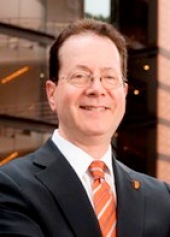
tired of waiting.
(Photo: Lewis & Clark)
One month after a Lewis and Clark College student was seriously injured in a collision on SW Barbur Blvd, the president of that institution is calling on the City of Portland, Metro, and the Oregon Department of Transportation to take immediate actions that will lead to better conditions for biking and walking.
Barry Glassner has sent a letter (PDF) to PBOT Transportation Commissioner Steve Novick, ODOT Region 1 Manager Jason Tell, and Metro Councilors Bob Stacey and Craig Dirksen, encouraging them to “work together to devise creative solutions which substantially improve bicycle and pedestrian safety in the short term.”
The letter is dated September 19th and it was made public today by Friends of Barbur, a volunteer group working to improve conditions the notoriously dangerous street.
In the letter, Glassner says he and his staff are actively encourage members of their student body and faculty to ride bikes or walk to campus. However, he writes, “We need to feel confident that they are not putting themselves in harm’s way by making this transportation choice.”
“We have a special interest in the members of our community having confidence they can safely use Barbur to get to and from Lewis and Clark without a car,” reads the letter.
Glassner refers to Metro’s ongoing SW Corridor transportation planning process, but he also notes how that’s a long-range plan that might not bear real fruit for decades. Therefore, writes Glassner, “It’s important to consider the present safety and needs” of people who use Barbur.
Barbur has seen a steady stream of injuries and fatalities over the years. While it was a very serious collision to one of his own students that might have spurred Glassner’s activism on this issue, just yesterday another person trying to use Barbur without a car was sacrificed to the gods of the status quo.
Many people feel the best “creative solution” out there for Barbur is a road diet to slow people down and create more pleasant cycling conditions. At this point however, ODOT hasn’t budged from their dismissive and dishonest position to maintain the lane configuration that puts a top priority on auto speeds and capacity. Will this letter from the leader of a prominent and respected local institution move the needle and bring ODOT to the table? Stay tuned.

